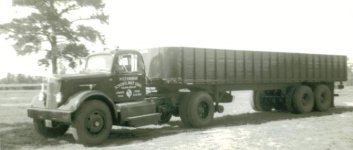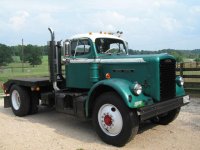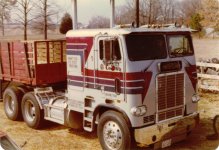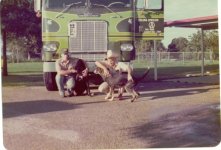Ah yes, the transition from cabovers to conventionals in the United States...
Some of the changeover was due to status sysbol of driving a conventional. That spawned rumors that cabovers were dangerous because your the first thing that hits after the windshield in a crash. The availability to see much better from a cabover with their huge windsheilds and panaramic view would give you a better chance of avoiding the accident in the first place. However, anything to get the companies to buy the "elite conventionals" was often pushed by the drivers.
I have driven both, and the ride of a vehicle is mostly determined by the distance between the front axle and the front tandom axle of the drivers, and just where you place the operator in that equation. Put him halfway between the two and you have the best ride available, which is why conventionals are so sought after. However, along the same times as conventionals started getting the thumbs up for riding better, also came the implementation of other important aspects, such as air ride seatsm air ride suspensions and air ride cabs. Depending on the manufacturer of the truck and the degree that the buyer was willing to spend his hard earned money had a lot to do with the ride of the truck. An early model truck conventional would be hard pressed to keep up the the technology of the last cabovers built here. For people who are driving them regularly over long periods of time, a cabover has definite advantages, as they are larger, much more room and storage. However, (and even this changed late in the cabovers) was the fact that you had to climb out of your chair onto a flat area (known as the dog box) in order to get to your bed. You literally sat in a hole between the engine and the door and if you wanted to go to bed, you stood up, stepped on your seat and walked to the bed. With a conventional, you just turned in your seat and in the early days, crawled thru a hole to get to your bed. Then they emplemented the one piece cab, which lead to opening up the cab to the bunk instead of having to crawl back thru a hole.(originally a rear window opening)
Basically, the whole effect of the loss of the cabovers, was due to drivers wanting more and more comfort and style. Companies driving cabover fleets had more and more trouble getting drivers and during a driver shortage, they were in trouble. (Ask JB Hunt why they changed) They either had to hire trainees and expect to loose them as soon as they had enough experience to go to work for somebody else, pay a lot more money than anyone else was willing to pay to drive their cabovers, or as cabovers became worn out, replace them with conventionals. (From a company standpoint, a cabover is a much better deal but it doesn't attract drivers, which is what it takes to make the wheels roll)
David from jax
Been trucking since 03/80



